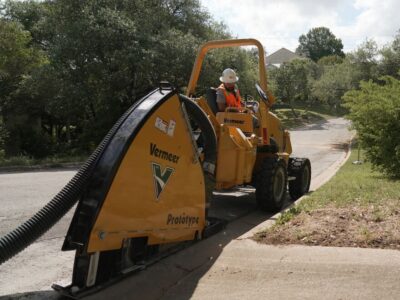When B COMM Constructors LLC rolled onto a residential street in Austin, Texas, with the new Vermeer MTR516 microtrencher attachment, they weren’t just there to complete another fiber install. They were helping test the next generation in microtrenching.
As a longtime Vermeer customer, B COMM was selected to test the MTR516 prototype in real-world conditions. The jobsite: a dense neighborhood with narrow streets, limited easements and homeowners who value clean, unobtrusive work. The goal: install fiber quickly, safely and with minimal disruption.
“We loved it,” Joel Anzaldua, microtrenching foreman for B COMM, said of the MTR516.
The Vermeer MTR516 is a high-performance microtrencher attachment designed for fiber installation in paved urban environments. Compatible with Vermeer RTX550 and RTX750 ride-on tractors, it cuts trenches from 1 in to 2 in (2.5 cm to 5.1 cm) wide and up to 17 in (43.2 cm) deep — ideal for creating narrow, clean trenches in asphalt or concrete with minimal surface disruption.
Here’s why B COMM operators loved the new Vermeer MTR516:
How does microtrenching support efficient fiber installation?
Microtrenching has emerged as a preferred method for fiber deployment in cities due to its speed, precision and reduced impact on surrounding infrastructure. According to the Fiber Broadband Association, microtrenching is now recognized in broadband deployment guidelines across the U.S. for its ability to accelerate fiber builds while minimizing restoration costs.
“Homeowners love it,” Anzaldua said of microtrenching. “We don’t really have to go into their landscaping, messing everything up. We try to stay in the street as much as we can. That way we don’t go onto their property and … damage anything. It’s definitely (cleaner and faster).”
What performance benefits did B COMM see with the MTR516 microtrencher?
In fiber installation, trench depth is critical — especially in urban environments where contractors must balance utility clearance, spoil management and surface restoration. While many microtrenchers on the market max out at 16 in (40.6 cm), the Vermeer MTR516 offers a cutting depth of up to 17 in (43.2 cm). That additional inch may seem small, but it can make a significant difference in achieving a clean trench bottom, especially when spoil or debris accumulates during cutting.
“It goes all the way to 17 inches deep,” Anzaldua said. “With the other machines we usually use, they goes to only 16. So sometimes we have a harder time to keep the trench clean and scratching with hooks and everything. And with this one giving us that extra inch, that really helps us a lot.”
This added depth is especially valuable considering that fiber optic cables are typically buried 12 in to 24 in (30.5 cm to 61 cm) deep in urban areas, depending on local regulations and surface conditions. The MTR516’s 17 in capability helps ensure clean trench bottoms even when working near the lower end of that range.
What features of the MTR516 help crews work more efficiently?
The MTR516 is engineered for jobsite cleanliness and uptime. Its fully shrouded cutting wheel contains debris and boosts vacuum suction, reducing cleanup time. A hydraulic swing cylinder allows for precise trench placement, and dual hinged access panels simplify cutter wheel maintenance.
“It’s a really good machine,” Anzaldua said. “It’s a much faster machine than the other ones we use. It’s much stronger.”
How does Vermeer support its microtrenching customers?
For John Carver, sales representative at Vermeer Texas-Louisiana, the opportunity to support B COMM with the MTR516 was more than just a product demo — it was a continuation of an important partnership.
“B COMM’s been partners with Vermeer for probably about 10 years now, maybe a little over. … We’ve been providing them equipment from micro trenchers, vacs, mini skid steers, drills — all across the board,” said Carver, their sales representative. “They’ve been doing microtrenching since Google came around the first time, quite a while ago.”
Vermeer Texas-Louisiana saw B COMM as an ideal partner to try out the MTR516.
“People always get excited about testing new things and especially when it comes to prototypes,” Carver said. “I think they really enjoyed seeing this unit run.”
How does the MTR516 microtrencher integrate with other Vermeer equipment?
To support spoil management and jobsite cleanliness, the MTR516 features a replaceable spoil outlet that connects to 4-in or 6-in (10.2-cm or 15.2-cm) vacuum hoses, making it easy to pair with Vermeer vacuum excavators for efficient debris removal. This integration helps reduce cleanup time and supports a cleaner, safer work zone — especially important in residential neighborhoods.
For post-trenching tasks like backfilling or material handling, Vermeer mini skid steers and compact articulated loaders can be deployed to streamline operations in tight spaces. And when deeper or more complex utility installations are required, the Vermeer lineup of horizontal directional drills (HDD) offers an additional solution for underground boring.
The Vermeer MTR516 microtrencher is designed to be more than just an attachment — it’s a key component in a larger system of Vermeer underground utility equipment that supports efficient, scalable fiber installation.
It has an early believer in B COMM.
“You guys should definitely go for it,” Anzaldua said. “It would be really useful for microtrench operations.”
This article contains third-party observations, advice or experiences that do not necessarily reflect the opinions of Vermeer Corporation, its affiliates or its dealers. Testimonials and/or endorsements by customers in specific circumstances may not be representative of normal circumstances experienced by all customers.
Vermeer Corporation reserves the right to make changes in engineering, design and specifications; add improvements; or discontinue manufacturing at any time without notice or obligation. Equipment shown is for illustrative purposes only and may display optional accessories or components specific to their global region. Please contact your local Vermeer dealer for more information on machine specifications. All other trademarks, registered trademarks and service marks are the property of their respective owners. Vermeer, the Vermeer logo and Equipped to Do More are trademarks of Vermeer Manufacturing Company in the U.S. and/or other countries.
© 2025 Vermeer Corporation. All Rights Reserved.
